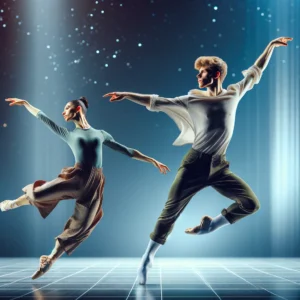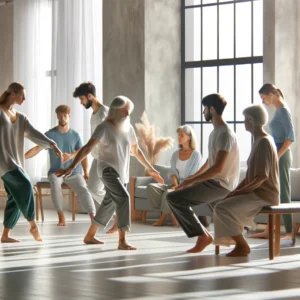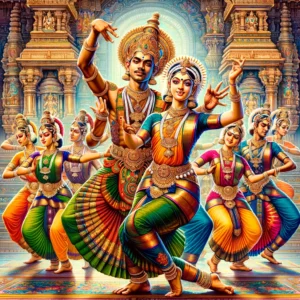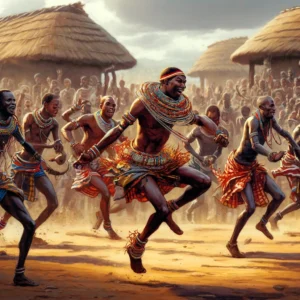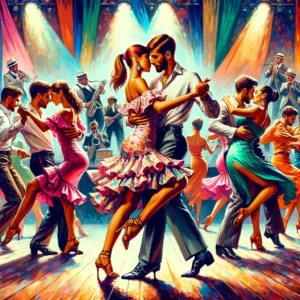 Dance has been a part of human culture for centuries, serving as a means of communication, celebration, and storytelling. From ancient tribal rituals to modern-day performances, dance has evolved and adapted to reflect the changing times and societies. It has become a powerful form of expression, allowing individuals to convey their thoughts, feelings, and experiences through movement.
Dance has been a part of human culture for centuries, serving as a means of communication, celebration, and storytelling. From ancient tribal rituals to modern-day performances, dance has evolved and adapted to reflect the changing times and societies. It has become a powerful form of expression, allowing individuals to convey their thoughts, feelings, and experiences through movement.
One of the most remarkable aspects of dance is its ability to transcend language barriers. When words fail to capture the complexity of our emotions, dance steps in to fill the void. Through the fluidity of movement, dancers can communicate joy, sadness, anger, and love in a way that resonates with people from all walks of life. It is a language that speaks directly to the heart, bypassing the constraints of vocabulary and grammar.
Moreover, dance has the power to inspire and uplift us. When we watch a skilled dancer gracefully leap across the stage or effortlessly glide across the dance floor, we are reminded of the limitless potential of the human body. We are inspired to push ourselves beyond our perceived limitations and explore the depths of our own physicality. Dance teaches us the importance of discipline, perseverance, and dedication, as it requires years of training and practice to master even the simplest of movements.
Beyond the physicality of dance, it also serves as a form of therapy and healing. Many individuals find solace in dance, using it as a means to cope with trauma, stress, or emotional pain. The act of moving one’s body in a rhythmic and intentional manner can be incredibly cathartic, allowing individuals to release pent-up emotions and find a sense of inner peace. Dance therapy has been proven to be effective in treating a variety of mental health conditions, including depression, anxiety, and PTSD.
In addition to its individual benefits, dance has the power to bring people together and foster a sense of community. Whether it’s a group of friends gathering for a night of salsa dancing or a professional dance company performing on a grand stage, dance has a way of uniting people from diverse backgrounds and creating a shared experience. It breaks down barriers and creates a sense of belonging, as individuals come together to celebrate the beauty and power of movement.
In conclusion, dance is a remarkable art form that goes beyond mere entertainment. It is a universal language that allows us to express ourselves, inspire others, heal our wounds, and build connections with one another. Through dance, we can tap into the depths of our creativity, unleash our emotions, and embrace the power of movement as a form of expression. So, let us celebrate the magic of dance and allow it to enrich our lives in ways we never thought possible.
As we delve deeper into the world of dance, we begin to understand that it is not just a physical activity but a form of art that has the power to transform us. Dance becomes a means of self-expression, a way to communicate our deepest thoughts and emotions without uttering a single word.
Through dance, we can tell stories, convey messages, and share our unique perspectives with the world. Each movement, each gesture, becomes a brushstroke on the canvas of our bodies, painting a picture of our innermost desires, fears, and dreams.
But dance is not just about the individual; it is also about connection. When we dance with others, we enter into a dialogue, a conversation that transcends language barriers and cultural differences. We learn to trust, to listen, and to respond to the movements of our partners, creating a harmonious and synchronistic dance that is greater than the sum of its parts.
And as we immerse ourselves in the world of dance, we discover that it is not limited to a specific age, gender, or background. Dance is a universal language that speaks to the hearts of all who are willing to listen. It is a celebration of diversity and a testament to the power of human creativity and expression.
So whether we are beginners taking our first tentative steps or seasoned professionals gracing the stage, dance has the ability to bring us joy, fulfillment, and a sense of belonging. It is a lifelong journey of discovery, growth, and self-discovery, and one that we are privileged to embark on.
Furthermore, dance can also have a positive impact on self-esteem and body image. As individuals learn and master new dance moves, their confidence grows, and they develop a sense of pride in their abilities. This can translate into improved self-esteem and a more positive body image, as dancers come to appreciate and celebrate the strength and beauty of their bodies.
In addition to the physical and mental benefits, dance also offers social benefits. Dancing often takes place in a group or community setting, providing opportunities for social interaction and connection. Whether it’s participating in a dance class, joining a dance team, or attending dance performances, dancers have the chance to meet new people, make friends, and build a sense of belonging.
Moreover, dance can serve as a means of cultural expression and preservation. Different dance styles and traditions are deeply rooted in various cultures around the world. Through dance, individuals can learn about and appreciate different cultural practices, customs, and histories. This not only fosters a sense of cultural awareness and understanding but also helps to preserve and pass down traditions from one generation to the next.
Lastly, dance can be a form of personal expression and a way to communicate emotions and stories. Whether it’s through graceful movements in ballet, energetic footwork in hip-hop, or passionate gestures in contemporary dance, dancers have the ability to convey their thoughts and feelings without words. This can be a cathartic and empowering experience, allowing individuals to express themselves in a unique and creative way.
In conclusion, dance offers a multitude of physical, mental, social, cultural, and emotional benefits. From improving fitness and mental well-being to fostering social connections and cultural appreciation, dance is a powerful art form that enriches the lives of individuals and communities alike.
Dance as a Form of Self-Expression
One of the most beautiful aspects of dance is its ability to serve as a powerful form of self-expression. Through movement, we can convey emotions, tell stories, and share our innermost thoughts without uttering a single word.
Whether it’s the fluidity and grace of a ballet dancer, the strength and power of a contemporary dancer, or the passion and sensuality of a tango dancer, each dance style offers a unique way to express ourselves. We can use dance to communicate joy, sadness, anger, love, and everything in between. It allows us to connect with others on a deep, emotional level, creating a sense of unity and understanding.
Furthermore, dance allows us to explore and embrace our individuality. It encourages us to embrace our bodies, celebrate our strengths, and express our true selves without fear of judgment. In a world that often tries to dictate how we should look and behave, dance provides a safe space where we can be authentically ourselves.
When we dance, we are not just moving our bodies; we are expressing our unique perspectives, experiences, and identities. Each individual brings their own story to the dance floor, and through their movements, they are able to share a piece of themselves with the world. Whether it’s a choreographed routine or an improvised freestyle, dance allows us to tap into our creativity and show the world who we truly are.
Moreover, dance can also be a form of catharsis and healing. It provides an outlet for emotions that may be difficult to express in other ways. For example, someone who has experienced trauma may find solace in the rhythmic movements of contemporary dance, allowing them to release pent-up emotions and begin the process of healing.
Additionally, dance can be a means of cultural expression and preservation. Different cultures have their own unique dance traditions, each with its own history, meaning, and symbolism. By participating in these traditional dances, individuals can connect with their heritage, honor their ancestors, and keep their cultural traditions alive.
Overall, dance is a powerful tool for self-expression, allowing individuals to communicate their thoughts, emotions, and identities in a way that transcends language. It provides a platform for creativity, healing, and cultural preservation, and allows us to connect with others on a deeper level. So, whether you’re a professional dancer or simply someone who loves to move, embrace the power of dance and let your body speak volumes.
As we embark on this lifelong journey of dance, we must remember that it is not just about the steps and the technique. It is about the emotions we convey, the stories we tell, and the connections we make. Dance is a language of its own, a universal language that can be understood by anyone, regardless of their background or culture.
Through dance, we can express our deepest emotions and communicate with others in a way that words cannot. It allows us to tap into our innermost thoughts and feelings, and to share them with the world. Whether it is the grace and elegance of ballet, the passion and intensity of flamenco, or the energy and rhythm of hip-hop, each style of dance has its own unique voice and message.
But dance is not just about the performance. It is also about the process, the hours of practice and dedication that go into perfecting our craft. It is about pushing ourselves to new limits, overcoming challenges, and constantly striving for improvement. It teaches us discipline, perseverance, and the value of hard work. It shows us that with determination and a strong work ethic, we can achieve anything we set our minds to.
Furthermore, dance is a form of self-discovery. It allows us to explore our bodies, to understand our strengths and weaknesses, and to push ourselves beyond our comfort zones. It teaches us to be present in the moment, to listen to our bodies, and to trust our instincts. Through dance, we learn to embrace vulnerability and to let go of inhibitions, allowing us to truly be ourselves.
Moreover, dance brings us joy. It is a source of happiness and fulfillment that goes beyond the physical. When we dance, we enter a state of flow, where time seems to stand still and we are completely absorbed in the present moment. It is a form of meditation, a way to quiet the mind and connect with our innermost selves. The sheer joy of moving to the music, of feeling the rhythm in our bones, is an experience like no other.
So let us embrace dance as a form of expression, as a way to connect with others and with ourselves. Let us celebrate the beauty and power of movement, and the joy it brings to our lives. Dance is not just a hobby or a profession, it is a way of life. It is a lifelong journey of self-discovery, growth, and connection. And as we continue on this journey, let us remember to dance with our hearts, to express ourselves fully, and to always find joy in the movement.
To delve deeper into the world of dance and enrich your understanding or book content, you might find the following types of resources useful:
Books: Look for comprehensive texts on the history and cultural significance of dance across different societies. Books like “Dance and Its Audience: Appreciating the Art of Movement” by Tami M. Spry and “Dancing: The Pleasure, Power, and Art of Movement” by Gerald Jonas provide excellent insights.
Documentaries and Films: Documentaries like “Pina” about the contemporary dancer and choreographer Pina Bausch, or “Dancing Dreams” which follows teenagers preparing a dance piece, offer a visual and emotional exploration of dance.
Online Courses: Websites like Udemy, Coursera, or even YouTube have tutorials and courses on dance history, styles, and techniques which can be very educational if you want a more structured learning path.
Dance Therapy Resources: The American Dance Therapy Association website is a valuable resource for understanding the therapeutic aspects of dance and finding relevant training and workshops.
Cultural and Ethnographic Studies: Look for articles and studies in databases like JSTOR or Google Scholar that discuss dance in specific cultural contexts, its role in society, and its evolution.
Local Dance Schools or Cultural Centers: Engaging with local dance communities or attending performances can provide practical insights and inspiration.
Here are some valuable resources and links that delve into the rich history and cultural significance of dance:
] A vibrant scene of an ancient tribal dance, depicting diverse tribal members in traditional attire, energetically performing around a fire in a forest
“The Evolution of Dance” explores the journey of dance forms throughout history, highlighting its profound cultural significance. It covers various styles from ancient rituals to modern-day performances, illustrating dance as a universal language of expression. You can explore this topic in detail at Dance Topia here.

A modern dance performance on a brightly lit stage, showcasing a male and female dancer in contemporary costumes. The dancers are caught in a dynamic, “Exploring the Cultural Significance of Traditional Dances Around the World” offers insights into traditional dances from different cultures such as Flamenco, Hula, Bharatanatyam, and more. Each section discusses the origins, symbolism, and roles these dances play in their communities. This can be a great resource for understanding how traditional dances preserve cultural heritage. Learn more about it on DANS-ME here.
“Tap Dancing America: A Cultural History”

An intimate dance therapy provides an intercultural history of tap dance in America, discussing its evolution from Afro-Irish percussive step dances to modern tap dancing. This comprehensive resource highlights the musical styles and social exchanges that influenced tap dance. You can access it through Oxford Academic here.

For books, “Dance and Its Audience: Appreciating the Art of Movement” by Tami M. Spry and “Dancing: The Pleasure, Power, and Art of Movement” by Gerald Jonas are excellent choices for further reading. They offer deeper insights into the interaction between dance and its viewers and the intrinsic values of movement as an art form.


These resources should provide a strong foundation for understanding the diverse aspects of dance and its role in culture and society.


